-

新人教版高中英语必修3Unit 2 Morals and Virtues教学设计三
The joke set her crying.这个玩笑使她哭起来。Step 5 ReadingActivity 31. Students read the small text in activity 3. The teacher provides several small questions to check whether students understand the content of the text and the ideographic function of the -ing form in the text.*Where are those people?*Why did Dr Bethune come to China?*How did he help the Chinese people during the war?*What did Chairman Mao Zedong say about him?2. Ss try to rewrite some sentences using the -ing form. Then check the answers. When checking the answers, the teacher can ask different students to read the rewritten sentences and give comments.Answers:1. he became very interested in medicine, deciding to become a doctor.2. …after hearing that many people were dying in the war.3. Helping to organise hospitals, he taught doctors and nurses, and showed people how to give first aid./ He helped to organise hospitals, teaching doctors and nurses, and showing people how to give first aid.4. …praising Dr Bethune as a hero to be remembered in China.Step 6 PracticeActivity 4Students complete grammar activities 2 and 3 on page 69 of the workbook.Step 6 Homework1. Understand and master the functions and usage of the -ing form;2. Finish the other exercises in Using structures.1、通过本节内容学习,学生是否理解和掌握动词-ing形式作宾语补足语语和状语语的功能和意义;2、通过本节内容学习,学生能否正确使用动词-ing形式描述人物的行为、动作及其经历;3、通过本节内容学习,学生能否独立完成练习册和导学案中的相关练习。

新人教版高中英语必修3Unit 2 Morals and Virtues教学设计四
3.Teachers ask different groups to report the answers to the questions and ask them to try different sentence patterns.The teacher added some sentence patterns for students to refer to when writing.Step 4 Writing taskActivity 51.Write the first draft.Students first review the evaluation criteria in activity 5, and then independently complete the draft according to the outline of activity 4, the answers to the questions listed in the group discussion and report, and the reference sentence pattern.2.Change partners.The teacher guides the students to evaluate their partner's composition according to the checklist of activity 5 and proposes Suggestions for modification.3.Finalize the draft.Based on the peer evaluation, students revise their own compositions and determine the final draft.Finally, through group recommendation, the teacher selects excellent compositions for projection display or reading aloud in class, and gives comments and Suggestions.Step 5 Showing writingActivity 5T call some Ss to share their writing.Step 6 Homework1. Read the passage in this section to better understand the passage.2. Carefully understand the hierarchical structure of the article, and deeply understand the plot of the story according to the causes, process and results;3. Independently complete the relevant exercises in the guide plan.1、通过本节内容学习,学生是否理解和掌握阅读文本中的新词汇的意义与用法;2、通过本节内容学习,学生能否通过人物言行的对比分析道德故事的深层内涵;3、通过本节内容学习,学生能否根据故事的起因、经过和结果来深入理解故事的情节,从而了解文章的层次结构;4、结合现实生活案例发表自己的见解和看法,写一篇观点明确、层次分明的故事评论。

新人教版高中英语必修3Unit 2 Morals and virtues教学设计一
(2) students are divided into groups according to the requirements of activity 3. Each student shares a story of personal experience or hearing-witnessing kindness, and then selects the most touching story in the group and shares it with the whole class. Before the students share the story, the teacher can instruct them to use the words and sentence patterns in the box to express. For example, the words in the box can be classified:Time order: first of all, then, after that, later, finally logical relationship :so, however, although, butTeachers can also appropriately add some transitional language to enrich students' expression:Afterwards, afterwards, at last, in the end, eventuallySpatial order: next to, far from, on the left, in front ofOtherwise, nevertheless, as a result, therefore, furthermore, in addition, as well asSummary: in a word, in short, on the whole, to sum up, in briefStep 8 Homework1. Understand the definition of "moral dilemma" and establish a correct moral view;2. Accumulate vocabulary about attitudes and emotions in listening texts and use them to express your own views;3. Complete relevant exercises in the guide plan.1、通过本节内容学习,学生能否理解理解“道德困境”的定义;2、通过本节内容学习,学生能否通过说话人所表达的内容、说话的语气、语调等来判断其态度和情绪;3、通过本节内容学习,学生能否针对具体的道德困境发表自己的看法和见解,能否掌握听力理训练中的听力策略。

新人教版高中英语必修3Unit 3 Diverse Cultures教学设计三
The price is the same as(the price was)before the war.价格与战前相同。(4)定语从句中的“关系代词+助动词be”可以省略。The ticket(that/which was)booked by his sister has been sent to him.他妹妹订的那张票已送到了他那里。Step 5 PracticeActivity 3(1) Guide students to complete the four activities in the Using Structures part of exercise book, in which activities 1 and 2 focus on ellipsis in dialogue answers, activity 3 focus on signs and headlines, two typical situations where ellipsis is used, and activity 4 focus on ellipsis in diary, an informal style.(2) Combine the examples in the above activities, ask students to summarize the omitted situations in groups, and make their own summary into a poster, and post it on the class wall after class to share with the class.(This step should give full play to the subjectivity of students, and teachers should encourage students to conclude different ellipsis phenomena according to their own understanding, they can conclude according to the different parts omitted in the sentence.)Step 6 Homework1. Understand and master the usages of ellipsis;2. Finish the other exercises in Using structures of Workbook.1、通过本节内容学习,学生是否理解和掌握省略的用法;2、通过本节内容学习,学生能否根据上下文语境或情景恢复句子中省略的成分,体会使用省略的效果;3、通过本节内容学习,学生能否独立完成练习册和导学案中的相关练习。

新人教版高中英语必修3Unit 3 Diverse Cultures教学设计二
(2)Consolidate key vocabulary.Ask the students to complete the exercises of activity 6 by themselves. Then ask them to check the answers with their partners.(The first language:Damage of the 1906 San Francisco earthquake and fire.A second language: Yunnan - one of the most diverse provinces in China).Step 5 Language points1. The teacher asks the students to read the text carefully, find out the more words and long and difficult sentences in the text and draw lines, understand the use of vocabulary, and analyze the structure of long and difficult sentences.2. The teacher explains and summarizes the usage of core vocabulary and asks the students to take notes.3. The teacher analyzes and explains the long and difficult sentences that the students don't understand, so that the students can understand them better.Step 6 Homework1. Read the text again, in-depth understanding of the text;2. Master the use of core vocabulary and understand the long and difficult sentences.3. Complete relevant exercises in the guide plan.1、通过本节内容学习,学生是否理解和掌握阅读文本中的新词汇的意义与用法;2、通过本节内容学习,学生能否结合文本特点了解文章的结构和作者的写作逻辑;3、通过本节内容学习,学生能否了解旧金山的城市风貌、文化特色,以及加利福尼亚州的历史,体会多元文化对美国的影响。

新人教版高中英语必修3Unit 3 Diverse Cultures教学设计四
该板块的活动主题是“介绍一个有显著文化特征的地方”( Describe a place with distinctive cultural identity)。该板块通过介绍中国城继续聚焦中国文化。本单元主题图呈现的是旧金山中国城的典型景象, Reading and Thinking部分也提到中国城,为该板块作铺垫。介绍中国城的目的主要是体现中国文化与美国多元文化的关系,它是美国多元文化的重要组成部分。中国城也是海外华人的精神家园和传播中国文化的重要窗口,外国人在中国城能近距离体验中国文化。1. Read the text to understand the cultural characteristics of Chinatown in San Francisco and the relationship between Chinese culture and American multiculturalism;2. Through reading, learn to comb the main information of the article, understand the author's writing purpose and writing characteristics;3. Learn to give a comprehensive, accurate, and organized description of the city or town you live in;Learn to revise and evaluate your writing.Importance:1. Guide the students to read the introduction of Chinatown in San Francisco and grasp its writing characteristics;2. Guide students to introduce their city or town in a comprehensive, accurate and organized way;3. Learn to comb the main information of the article, understand the author's writing purpose, and master the core vocabulary.

新人教版高中英语必修3Unit 3 Diverse Cultures教学设计一
Activity 81.Grasp the main idea of the listening.Listen to the tape and answer the following questions:Who are the two speakers in the listening? What is their relationship?What is the main idea of the first part of the listening? How about the second part?2.Complete the passage.Ask the students to quickly review the summaries of the two listening materials in activity 2. Then play the recording for the second time.Ask them to complete the passage and fill in the blanks.3.Play the recording again and ask the students to use the structure diagram to comb the information structure in the listening.(While listening, take notes. Capture key information quickly and accurately.)Step 8 Talking Activity 91.Focus on the listening text.Listen to the students and listen to the tape. Let them understand the attitudes of Wu Yue and Justin in the conversation.How does Wu Yue feel about Chinese minority cultures?What does Justin think of the Miao and Dong cultures?How do you know that?2.learn functional items that express concerns.Ask students to focus on the expressions listed in activity. 3.And try to analyze the meaning they convey, including praise (Super!).Agree (Exactly!)"(You're kidding.!)Tell me more about it. Tell me more about it.For example, "Yeah Sure." "Definitely!" "Certainly!" "No kidding!" "No wonder!" and so on.4.Ask the students to have conversations in small groups, acting as Jsim and his friends.Justin shares his travels in Guizhou with friends and his thoughts;Justin's friends should give appropriate feedback, express their interest in relevant information, and ask for information when necessary.In order to enrich the dialogue, teachers can expand and supplement the introduction of Miao, dong, Lusheng and Dong Dage.After the group practice, the teacher can choose several groups of students to show, and let the rest of the students listen carefully, after listening to the best performance of the group, and give at least two reasons.
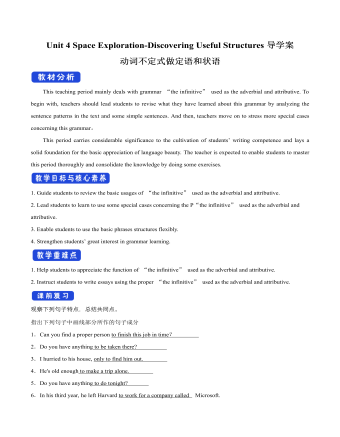
新人教版高中英语必修3Unit 4 Space Exploration-Discovering Useful Structures导学案
【点津】 1.不定式的复合结构作目的状语 ,当不定式或不定式短语有自己的执行者时,要用不定式的复合结构?即在不定式或不定式短语之前加 for +名词或宾格代词?作状语。He opened the door for the children to come in. 他开门让孩子们进来。目的状语从句与不定式的转换 英语中的目的状语从句,还可以变为不定式或不定式短语作状语,从而使句子在结构上得以简化。可分为两种情况: 1?当目的状语从句中的主语与主句中的主语相同时,可以直接简化为不定式或不定式短语作状语。We'll start early in order that/so that we may arrive in time. →We'll start early in order to/so as to arrive in time. 2?当目的状语从句中的主语与主句中的主语不相同时,要用动词不定式的复合结构作状语。I came early in order that you might read my report before the meeting. →I came early in order for you to read my report before the meeting.
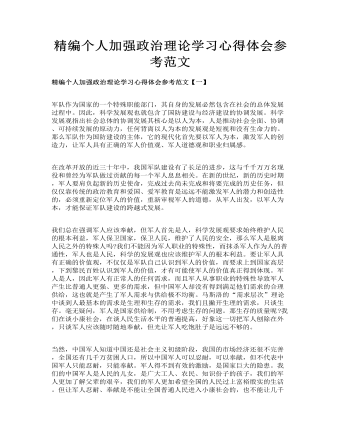
精编个人加强政治理论学习心得体会参考范文
在改革开放的近三十年中,我国军队建设有了长足的进步,这与千千万万名现役和曾经为军队做过贡献的每一个军人息息相关。在新的世纪,新的历史时期,军人要肩负起新的历史使命,完成过去尚未完成和将要完成的历史任务,但仅仅靠传统的政治教育和爱国、爱军教育是远远不能激发军人的潜力和创造性的,必须重新定位军人的价值,重新审视军人的道德,从军人出发,以军人为本,才能保证军队建设的跨越式发展。
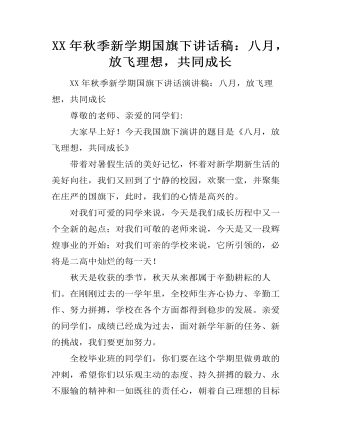
XX年秋季新学期国旗下讲话稿:八月,放飞理想,共同成长
XX年秋季新学期国旗下讲话演讲稿:八月,放飞理想,共同成长尊敬的老师、亲爱的同学们:大家早上好!今天我国旗下演讲的题目是《八月,放飞理想,共同成长》带着对暑假生活的美好记忆,怀着对新学期新生活的美好向往,我们又回到了宁静的校园,欢聚一堂,并聚集在庄严的国旗下,此时,我们的心情是高兴的。对我们可爱的同学来说,今天是我们成长历程中又一个全新的起点;对我们可敬的老师来说,今天是又一段辉煌事业的开始;对我们可亲的学校来说,它所引领的,必将是二高中灿烂的每一天!秋天是收获的季节,秋天从来都属于辛勤耕耘的人们。在刚刚过去的一学年里,全校师生齐心协力、辛勤工作、努力拼搏,学校在各个方面都得到稳步的发展。亲爱的同学们,成绩已经成为过去,面对新学年新的任务、新的挑战,我们要更加努力。
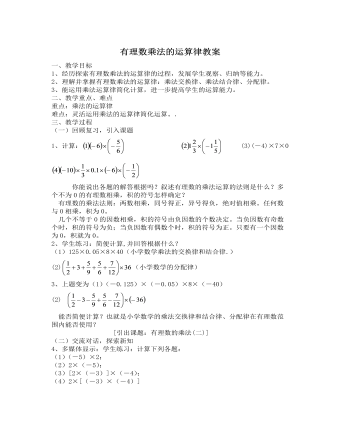
北师大初中七年级数学上册有理数乘法的运算律教案2
分析:(1)(2)用乘法的交换、结合律;(3)(4)用分配律,4.99写成5-0.01学生板书完成,并说明根据什么?略例3、某校体育器材室共有60个篮球。一天课外活动,有3个班级分别计划借篮球总数的 , 和 。请你算一算,这60个篮球够借吗?如果够了,还多几个篮球?如果不够,还缺几个?解:=60-30-20-15 =-5答:不够借,还缺5个篮球。练习巩固:第41页1、2、7、探究活动 (1)如果2个数的积为负数,那么这2个数中有几个负数?如果3个数的积为负数,那么这3个数中有几个负数?4个数呢?5个数呢?6个数呢?有什么规律? (2)逆用分配律 第42页 5、用简便方法计算(三)课堂小结通过本节课的学习,大家学会了什么?本节课我们探讨了有理数乘法的运算律及其应用.乘法的运算律有:乘法交换律:a×b=b×a;乘法结合律:(a×b)×c=a×(b×c);分配律:a×(b+c)=a×b+a×c.在有理数的运算中,灵活运用运算律可以简化运算.(四)作业:课本42页作业题
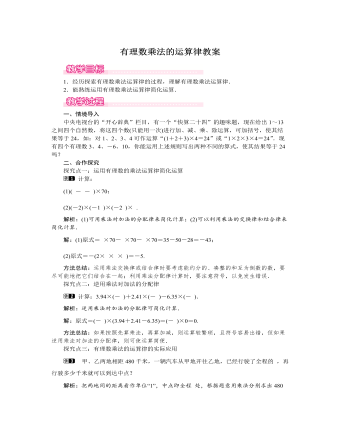
北师大初中七年级数学上册有理数乘法的运算律教案1
解:原式=(-47)×(3.94+2.41-6.35)=(-47)×0=0.方法总结:如果按照先算乘法,再算加减,则运算较繁琐,且符号容易出错,但如果逆用乘法对加法的分配律,则可使运算简便.探究点三:有理数乘法的运算律的实际应用甲、乙两地相距480千米,一辆汽车从甲地开往乙地,已经行驶了全程的13,再行驶多少千米就可以到达中点?解析:把两地间的距离看作单位“1”,中点即全程12处,根据题意用乘法分别求出480千米的12和13,再求差.解:480×12-480×13=480×(12-13)=80(千米).答:再行80千米就可以到达中点.方法总结:解答本题的关键是根据题意列出算式,然后根据乘法的分配律进行简便计算.新课程理念要求把学生“学”数学放在教师“教”之前,“导学”是教学的重点.因此,在本节课的教学中,不要直接将结论告诉学生,而是引导学生从大量的实例中寻找解决问题的规律.学生经历积极探索知识的形成过程,最后总结得出有理数乘法的运算律.整个教学过程要让学生积极参与,独立思考和合作探究相结合,教师适当点评,以达到预期的教学效果.
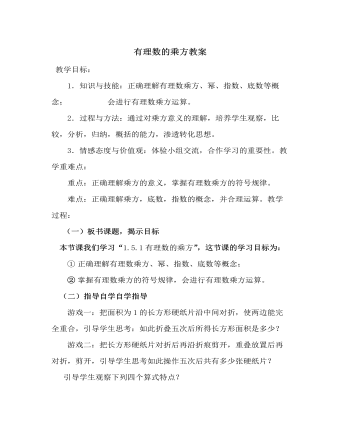
北师大初中七年级数学上册有理数的乘方教案2
二.思考:(-2) 可以写成-2 吗?( ) 可以写成 吗?(指名学生回答,师生共同总结:负数和分数的乘方书写时,一定要把整个负数和分数用小括号括起来)三.计算:①(-2) ,②-2 ,③(- ) ,④ (叫4个学生上台板演,其他练习本上完成,教师巡视,确保人人学得紧张高效).(四)讨论更正,合作探究1.学生自由更正,或写出不同解法;2.评讲思考:将三题①③中将底数换成为正数或0,结果有什么规律?学生总结:负数的奇次幂是负数,负数的偶次幂是正数,正数的任何次幂都是正数,0的任何正整数次幂都为0。有理数的乘方就是几个相同因数积的运算,可以运用有理数乘方法则进行符号的确定和幂的求值.乘方的含义:①表示一种运算;②表示运算的结果.
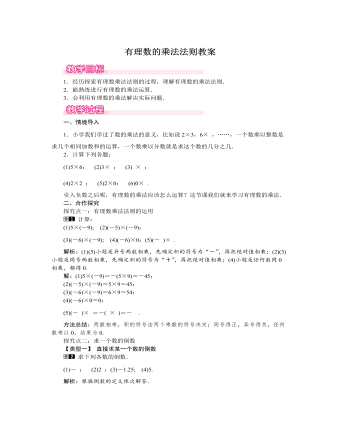
北师大初中七年级数学上册有理数的乘法法则教案1
解:由题意得a+b=0,cd=1,|m|=6,m=±6;∴(1)当m=6时,原式=06-1+6=5;(2)当m=-6时,原式=0-6-1+6=5.故a+bm-cd+|m|的值为5.方法总结:解答此题的关键是先根据题意得出a+b=0,cd=1及m=±6,再代入所求代数式进行计算.探究点三:有理数乘法的应用性问题小红家春天粉刷房间,雇用了5个工人,干了3天完成;用了某种涂料150升,费用为4800元,粉刷的面积是150m2.最后结算工钱时,有以下几种方案:方案一:按工算,每个工100元;(1个工人干1天是一个工);方案二:按涂料费用算,涂料费用的30%作为工钱;方案三:按粉刷面积算,每平方米付工钱12元.请你帮小红家出主意,选择哪种方案付钱最合算(最省)?解析:根据有理数的乘法的意义列式计算.解:第一种方案的工钱为100×3×5=1500(元);第二种方案的工钱为4800×30%=1440(元);第三种方案的工钱为150×12=1800(元).答:选择方案二付钱最合算(最省).方法总结:解此题的关键是根据题意列出算式,计算出结果,比较得出最省的付钱方案.
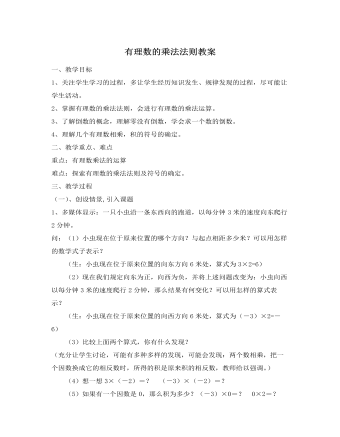
北师大初中七年级数学上册有理数的乘法法则教案2
讨论归纳,总结出多个有理数相乘的规律:几个不等于0的因数相乘,积的符号由负因数的个数决定。当负因数有奇数个时,积的符号为负;当负因数有偶数个时,积的符号为正。只要有一个因数为0,积就为0。(2)几个不等于0的因数相乘时,积的绝对值是多少?(生:积的绝对值是这几个因数的绝对值的乘积.)例2、计算:(1) ;(2) 分析:(1)有多个不为零的有理数相乘时,可以先确定积的符号,再把绝对值相乘;(2)若其中有一个因数为0,则积为0。解:(1) = (2) =0练习(1) ,(2) ,(3) 6、探索活动:把-6表示成两个整数的积,有多少种可能性?把它们全部写出来。(三)课堂小结通过本节课的学习,大家学会了什么?(1)有理数的乘法法则。(2)多个不等于0的有理数相乘,积的符号由负因数的个数决定。(3)几个数相乘时,如果有一个因数是0,则积就为0。(4)乘积是1的两个有理数互为倒数。(四)作业:课本作业题
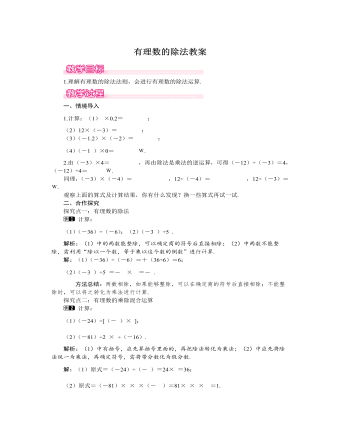
北师大初中七年级数学上册有理数的除法教案1
解析:∵ab>0,根据“两数相除,同号得正”可知,a、b同号,又∵a+b<0,∴可以判断a、b均为负数.故选D.方法总结:此题考查了有理数乘法和加法法则,将二者综合考查是考试中常见的题型,此题的侧重点在于考查学生的逻辑推理能力.让学生深刻理解除法是乘法的逆运算,对学好本节内容有比较好的作用.教学设计可以采用课本的引例作为探究除法法则的过程.让学生自己探索并总结除法法则,同时也让学生对比乘法法则和除法法则,加深印象.并讲清楚除法的两种运算方法:(1)在除式的项和数字不复杂的情况下直接运用除法法则求解.(2)在多个有理数进行除法运算,或者是乘、除混合运算时应该把除法转化为乘法,然后统一用乘法的运算律解决问题.
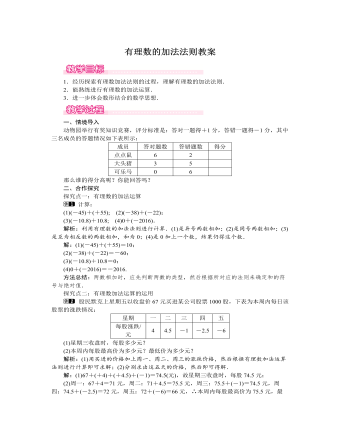
北师大初中七年级数学上册有理数的加法法则教案1
方法总结:股票每天的涨跌都是在前一天的基础上进行的,不要理解为每天都是在67元的基础上涨跌.另外熟记运算法则并根据题意准确列出算式也是解题的关键.三、板书设计加法法则(1)同号两数相加,取与加数相同的符号,把绝对 值相加.(2)异号两数相加,取绝对值较大加数的符号,并 用较大的绝对值减去较小的绝对值.(3)互为相反数的两数相加得0.(4)一个数同0相加,仍得这个数.本课时利用情境教学、解决问题等方法进行教学,使学生在情境中提出问题,并寻找解决问题的途径,因此不知不觉地进入学习氛围,把学生从被动学习变为主动想学.在本节教学中,要坚持以学生为主体,教师为主导,充分调动学生的兴趣和积极性,使他们最大限度地参与到课堂的活动中.
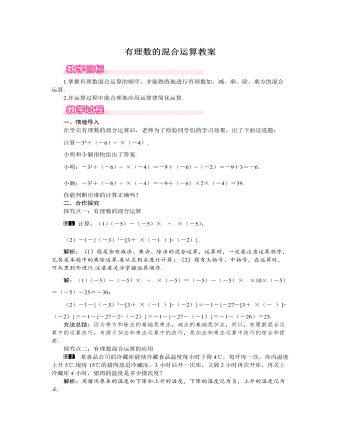
北师大初中七年级数学上册有理数的混合运算教案1
1.掌握有理数混合运算的顺序,并能熟练地进行有理数加、减、乘、除、乘方的混合运算.2.在运算过程中能合理地应用运算律简化运算.一、情境导入在学完有理数的混合运算后,老师为了检验同学们的学习效果,出了下面这道题:计算-32+(-6)÷12×(-4).小明和小颖很快给出了答案.小明:-32+(-6)÷12×(-4)=-9+(-6)÷(-2)=-9+3=-6.小颖:-32+(-6)÷12×(-4)=-9+(-6)×2×(-4)=39.你能判断出谁的计算正确吗?二、合作探究探究点一:有理数的混合运算计算:(1)(-5)-(-5)×110÷110×(-5);(2)-1-{(-3)3-[3+23×(-112)]÷(-2)}.解析:(1)题是含有减法、乘法、除法的混合运算,运算时,一定要注意运算顺序,尤其是本题中的乘除运算.要从左到右进行计算;(2)题有大括号、中括号,在运算时,可从里到外进行.注意要灵活掌握运算顺序.
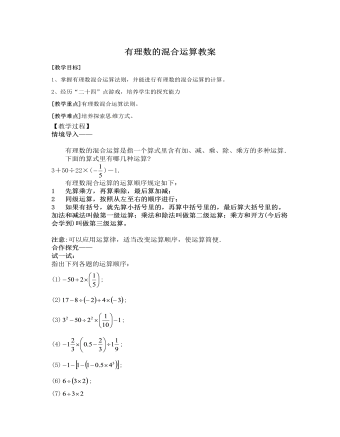
北师大初中七年级数学上册有理数的混合运算教案2
1、掌握有理数混合运算法则,并能进行有理数的混合运算的计算。2、经历“二十四”点游戏,培养学生的探究能力[教学重点]有理数混合运算法则。[教学难点]培养探索思 维方式。【教学过程】情境导入——有理数的混合运算是指一个算式里含有加、减、乘、除、乘方的多种运算.下面的算式里有哪几种运算?3+50÷22×( )-1.有理数混合运算的运算顺序规定如下:1 先算乘方,再算乘除,最后算加减;2 同级运算,按照从左至右的顺序进行;3 如果有括号,就先算小括号里的,再算中括号里的,最后算大括号里的。 加法和减法叫做第一级运算;乘法和除法叫做第二级运算;乘方和开方(今后将会学到)叫做第三级运算。注意:可以应用运算律,适当改变运算顺序,使运算简便.合作探究——
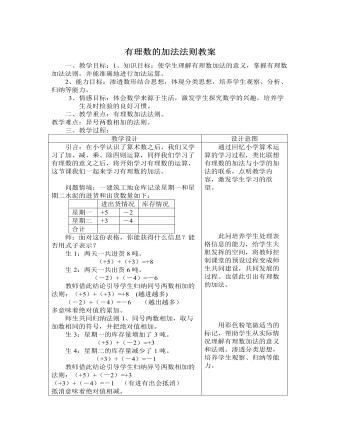
北师大初中七年级数学上册有理数的加法法则教案2
师生共同归纳法则2、异号两数相加,取绝对值较大的加数的符号,并用较大的绝对值减去较小的绝对值。生5:这两天的库存量合计增加了2吨。(+3)+(-1)=+2 或(+8)+(-6)=+2师:会不会出现和为零的情况?提示:可以联系仓库进出货的具体情形。生6:如星期一仓库进货5吨,出货5吨,则库存量为零。(+5)+(-5)=0师生共同归纳法则3、互为相反数的两个数相加得零。师:你能用加法法则来解释法则3吗?生7:可用异号两数相加的法则。一般地还有:一个数同零相加,仍得这个数。小结:运算关键:先分类运算步骤:先确定符号,再计算绝对值做一做:(口答)确定下列各题中和的符号,并说明理由:(1)(+3)+(+7);(2)(-10)+(-3);(3)(+6)+(-5);(4)0+(-5).例 计算下列各式:(1)(-3)+(-4);(2)(-2.5)+5;(3)(-2)+0;(4)(+ )+(- )教法:请四位学生板演,让学生批改并说明理由。

